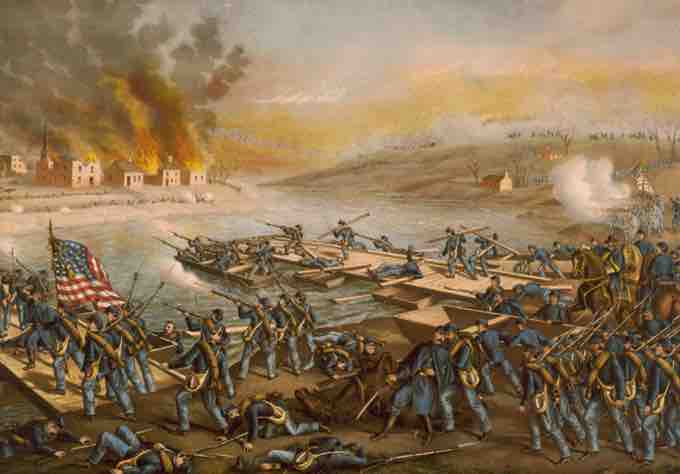Fredericksburg: A Union Defeat
In November 1862, President Abraham Lincoln needed to demonstrate the success of the Union war effort before the Northern public lost confidence in his administration. Confederate armies had been on the move earlier in the fall, invading Kentucky and Maryland, and although each had been turned back, those armies remained intact and capable of further action. Lincoln urged Major General Ulysses S. Grant to advance against the Confederate stronghold of Vicksburg, Mississippi. He replaced Major General Don Carlos Buell with Major General William S. Rosecrans, hoping for a more aggressive posture against the Confederates in Tennessee. On November 5, seeing that his replacement of Buell had not stimulated Major General George B. McClellan into action, he issued orders to replace McClellan in command of the Army of the Potomac in Virginia. McClellan had stopped Robert E. Lee at the Battle of Antietam in Maryland, but had not been able to destroy Lee's army, nor did he pursue Lee back into Virginia aggressively enough for Lincoln.
The Battle of Fredericksburg was fought December 11–15, 1862, in and around Fredericksburg, Virginia, between General Robert E. Lee's Confederate Army of Northern Virginia and the Union Army of the Potomac, commanded by Major General Ambrose Burnside. The Union Army's futile frontal attacks on December 13 against entrenched Confederate defenders on the heights behind the city is considered one of the most one-sided battles of the American Civil War, with Union casualties more than twice as heavy as those suffered by the Confederates.
Burnside's plan was to cross the Rappahannock River at Fredericksburg in mid-November and race to the Confederate capital of Richmond before Lee's army could stop him. Bureaucratic delays prevented Burnside from receiving the necessary pontoon bridges in time, and Lee moved his army to block the crossings. When the Union Army was finally able to build its bridges and cross under fire, urban combat began, and a battle raged in the city December 11–12. Union troops prepared to assault Confederate defensive positions south of the city and on a strongly fortified ridge just west of the city known as "Marye's Heights."
On December 13, the "grand division" of Major General William B. Franklin was able to pierce the first defensive line of Confederate Lieutenant General Stonewall Jackson to the south, but was ultimately repulsed. Burnside ordered the grand divisions of Major Generals Edwin V. Sumner and Joseph Hooker to make multiple frontal assaults against Lieutenant General James Longstreet's position on Marye's Heights, all of which were repulsed with heavy losses. On December 15, Burnside withdrew his army, ending another failed Union campaign in the eastern theater.

Battle of Fredericksburg: The Army of the Potomac crossing the Rappahannock in the morning of December 13, 1862, under the command of Generals Burnside, Sumner, Hooker, and Franklin
Due to the Union Army's logistical and bureaucratic delays, Lee's Army of Northern Virginia had set up well-fortified positions by the time of Burnside's attack. Burnside's troops came under heavy fire while trying to cross the Rappahannock River near Fredericksburg.